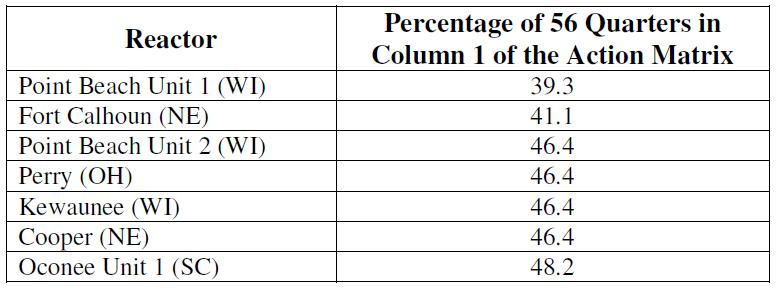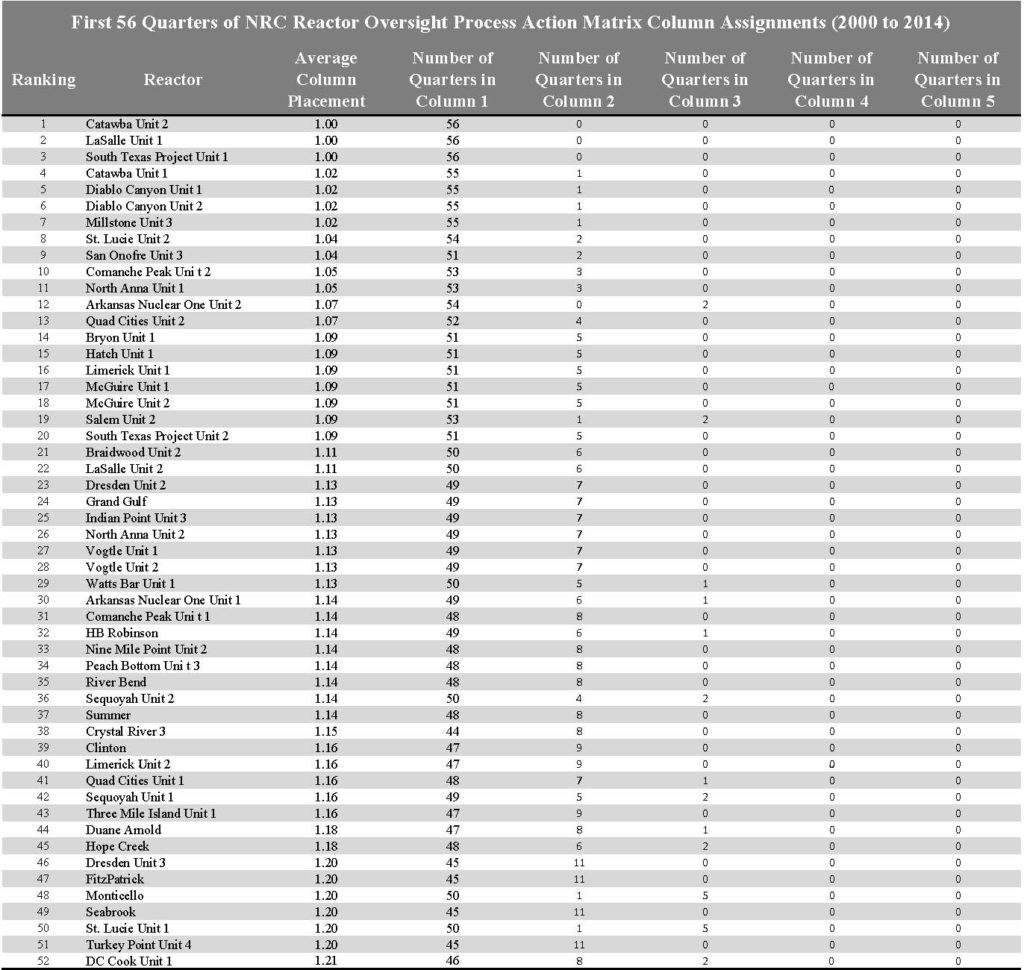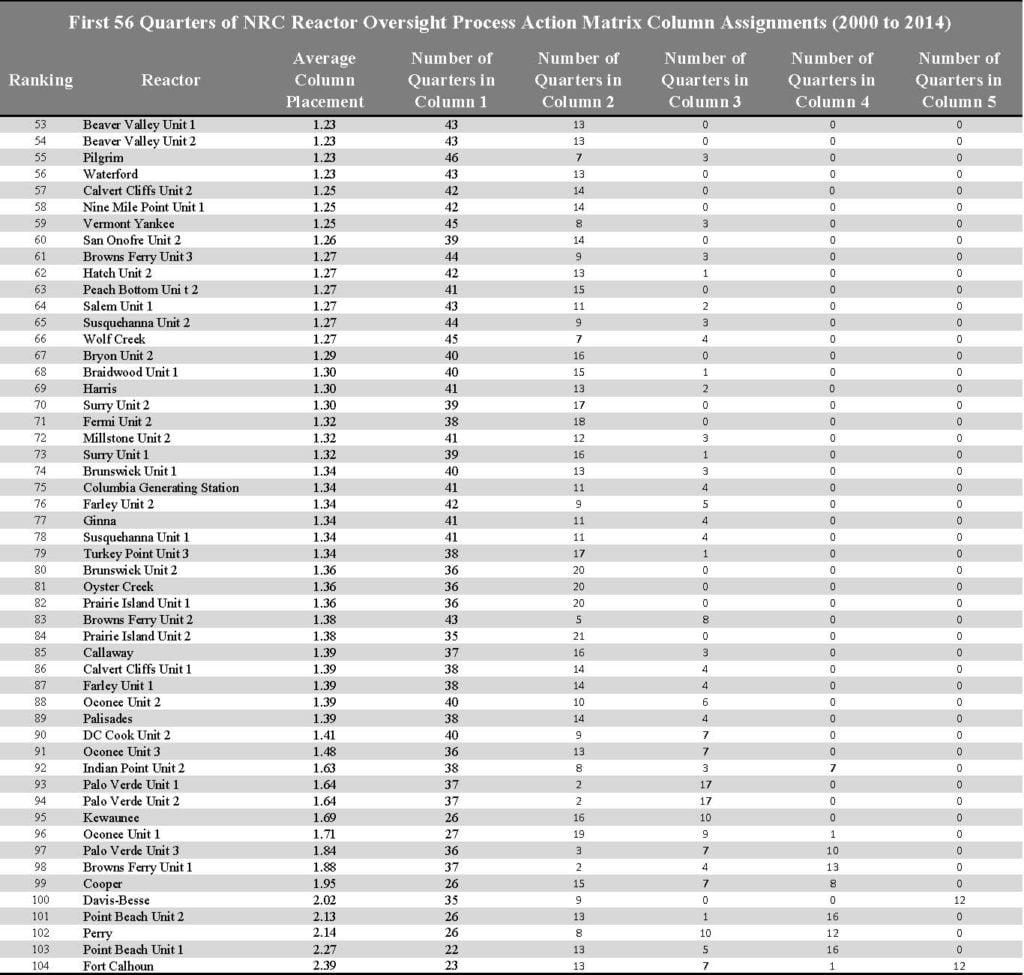Nuclear Energy Activist Toolkit #53
NEAT #52 acknowledged the stellar results achieved by Catawba Unit 2, LaSalle Unit 1, and South Texas Project Unit 1 by remaining in Column 1 of the NRC’s Action Matrix for every one of the ROP’s first 56 quarters. They were the only three reactors in the nation to compile perfect attendance records.
This blog post discusses reactors that spent little time in Column 1 over that same 14-year period.
The Nuclear Regulatory Commission has posted performance results from the Reactor Oversight Process (ROP) the agency began using in 2000 to assess safety levels at the nation’s operating nuclear power reactors.
The ROP uses nearly two dozen Performance Indicators and findings by NRC inspectors to “grade” performance for each nuclear power reactor every quarter.
When the performance indicators fall within expected ranges and the NRC’s inspectors haven’t found serious problems, the NRC puts a reactor in the Licensee Response Column of the ROP’s Action Matrix.
If one or more performance indicators reveal declining performance and/or the NRC’s inspectors find more serious problems, the NRC places a reactor into other Action Matrix columns.
The Licensee Response Column, also called Column 1, is where reactors are supposed to be. When they are not, the NRC sends more and more of its inspectors to the site to more fully understand the context behind the declining performance and ensure the effectiveness of corrective actions intended to halt the decline and restore performance to the level needed to return to Column 1.
Seven reactors spent less than half of these 56 quarters in Column 1:
Nebraska only has two operating nuclear power reactors. Yet Fort Calhoun and Cooper combined spent less time in Column 1 than Catawba Unit 2 alone spent there.
The average nuclear power reactor in the United States spent 44 of the 56 quarters in Column 1. Point Beach Unit 1 spent only 22 quarters in Column 1—half the national average and merely 34 quarters (8 ½ years) less than Catawba Unit 2, LaSalle Unit 1, and South Texas Project Unit 1.None of the nuclear power reactors operating in Nebraska and Wisconsin spent more than half of the past 14 years in Column 1. Catawba Unit 2, LaSalle Unit 1, and South Texas Project Unit 1 spent every single moment of that time in Column 1. So it can be done—why can’t reactors in Nebraska and Wisconsin get it done?
Table 2 shows the Action Matrix column assignments during the ROP’s first 14 years for half of the reactors in the United States. The reactors are sorted in this table based on the number of quarters assigned to Column 1, the expected assignment.
As expected of top performers, when one of these reactors wasn’t in Column 1, it was most often in Column 2, the next best place. To be sure, there are occasion appearances in Column 3, but none of these 52 reactors spent even one quarter in either Column 4 or 5.
Like many football games, nuclear safety during the ROP’s first 14 years seems to be a tale of two halves. Table 3 shows the Action Matrix column assignments for the other half of the reactors. Again, the reactors are sorted based on the number of quarters assigned in Column 1.
Clearly, these reactors underperformed. Point Beach Unit 1 spent 16 quarters in Column 4 and only 22 quarters in Column 1. Fort Calhoun and Davis-Besse each spent 12 quarters (3 years) in Column 5 [NOTE: The NRC actually placed these reactors under its Manual Chapter 0350, “Oversight of Reactor Facilities in a Shutdown Condition Due to Significant Performance and/or Operational Concerns,” process while they were shut down correcting numerous safety problems. For accounting purposes, UCS considers such placement equivalent to being in Column 5.]
The Action Matrix columns are analogous to academic letter grades—Column 1 is like an A, Column 2 is like a B, and so on.
Palo Verde Units 1 and 2 had the most C’s with 17 each.
Point Beach Units 1 and 2 had the most D’s with 16 each.
And Davis-Besse and Fort Calhoun had the most E’s (or F’s, depending on the scholastic preference) with 12 each.
The first 52 reactors demonstrate that it is possible to consistently bring home quarterly report cards with A’s and B’s.
The other 52 reactors demonstrate that the ROP isn’t prone to grade inflation or doling out A’s and B’s simply for showing up—a reactor has to earn top scores.
Bottom Line
Point Beach Unit 1 was in Column 1 only 22 of the ROP’s first 56 quarters.
Catawba Unit 2, LaSalle Unit 1 and South Texas Project Unit 1 spent all 56 quarters in Column 1.
Is the NRC at fault for tolerating chronic underperformance?
As tempting as it is to answer yes, the better answer is no.
The NRC evaluates performance and allocates additional oversight resources to underperforming reactors. If that regulatory attention does not have the desired effect and performance drops too far, the NRC will require that reactors shut down until appropriate safety fixes are completed. Davis-Besse and Fort Calhoun each spent time in nuclear detention.
Just as teachers grade performance and devote extra attention to underperforming students, sometimes teachers need help. Parents can insist that children complete homework and study for tests. Parents can also arrange for tutors to help children learn.
The NRC is sending home report cards. Is senior management and the Board of Directors truly satisfied that Point Beach Units 1 and 2 received D’s in 16 of 56 quarters (28.5% of the time)? Likewise, are the stockholders with billions invested in the Perry nuclear plant satisfied that it earned nearly as many C’s and D’s as A’s over the past 14 years?
The NRC is doing its job issuing C’s, D’s, and F’s for underperformance and devoting additional resources in an effort to stem and reverse declining trends. Senior management and Board of Directors must earn their pay by ensuring measures are taken to stop chronic underperformers. There are literally billions of reasons to get it done.
Just do it.
The UCS Nuclear Energy Activist Toolkit (NEAT) is a series of post intended to help citizens understand nuclear technology and the Nuclear Regulatory Commission’s processes for overseeing nuclear plant safety.



